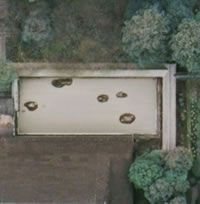| Page 1. |
 |
The first page proves geometrical laws of the Japanese garden of stones in The Temple Ryoanji or Ryoanzi in city of Kyoto. |
The traditional Japanese garden of stones is a systematic and harmonious
arrangement of objects on area which is in a vision of the observer and is space
where the observer sees objects and perceives topology of a harmonious
arrangement. Or it is possible to tell that the Japanese garden of stones is a
kind of space which is connected to position of the observer and forms a field
of vision where the observer perceives a harmonious arrangement of objects.
Usually gardens of stones are located near temples and are a part of the
architectural plan, namely form space which is external continuation of an
interior. And in essence gardens of stones form space where the harmonious
arrangement of stones creates impression of harmony of world around, and
contributes to the pacified contemplation or reflection (meditation).
It is considered that the first garden of stones was created in the temple Ryoanji or Ryoanzi
in Kyoto in ancient capital of Japan by the well-known master of Zen Buddhism
whose name is Soami (1480-1525). It is the most known Japanese garden of stones,
which otherwise called The Philosophic Garden or The Garden Ryoanji, and in
essence this garden is a canon which determines principles and rules according
to which it is necessary to have stones. Though not in all Japanese gardens of
stones this canon is observed, but nevertheless principles and rules of the
garden of stones in the temple Ryoanzi were basic initially.
Garden in the temple Ryoanzi is the small rectangular territory from the east to
the west of 30 meters and from the south to the north of 10 meters where 15
stones (rocks) are collected in five groups with three stones in each group.
Pay attention that numbers five and three are basic in Chinese numerology which
was borrowed by Japan alongside with the Buddhism, and
consequently 15 stones there are in the garden of Japanese temple Ryoanzi as number 15
turns out at multiplication of number 3 to number 5.
Look he information on numbers 5 and 3 in Chinese numerology
on pages of other site: www.emotions.64g.ru/prof2/pro1en.htm.
Near to territory of the garden there is the temple pavilion where there is a
place of contemplation ordered by tradition. If to look at the garden from this
place then it is possible to find out that apparent chaotic arrangement of
stones has bewitching influence on people, namely contemplation of stones
creates impression which allows to concentrate and find a harmonious condition
of consciousness. This impression of harmony seems inexplicable as people notice
a mysterious riddle which creates impression of bewitching harmony in the
arrangement of stones, but can not explain this riddle since when in 15 century
the garden of stones in the temple Ryoanzi was constructed.
In some cases people compared stones to clouds which are floating in the sky and
which create sensation of quiet and slow movement that involves consciousness in
a condition of the pacified rest. Or people compared stones to islands in the
sea which the man sees as if from height of the bird's flight, that also
involves consciousness in a condition of rest and creates impression of movement
which similarly to smooth movement of a bird.
Zen Buddhists saw in beauty of the garden of stones in the temple Ryoanzi some
inexplicable display of an incomprehensible nature of life and some image of the
incomprehensible esoteric law according to which there is a universe and life is
carried out, that coordinated to principles of the Zen Buddhism which denies
understanding of the world but supposes the not realized and spontaneous
following to laws of the world. Though actually laws of a universe and harmony
of a nature, and including mysterious harmony of the garden of stones of the
Japanese temple Ryoanzi, have an explanation in the certain geometrical laws.
Namely the secret of the garden of stones can be understood if to see a
geometrical network of lines which form the invisible geometrical drawing, that
is shown on the chart:

 |
The sight from the satellite on the garden of stones in the temple Ryoanji is shown at the right. Under a roof in pavilion there is the statue of Buddha and the place of contemplation. |
On the left chart the grey rectangular shows borders of the area where 5
groups of stones are located, that is shows borders of the garden of stones.
Point A in the bottom of the chart approximately corresponds with the centre of
temple pavilion and this point is a place of contemplation. Namely the point A
is in apex of a heptagon which forms a geometrical network of lines, and
accordingly this point is a place which allows to see the arrangement of stones
correctly agrees to lines of a heptagon or otherwise to tell according to lines
of a heptagonal geometrical network. As the arrangement of stones and borders of
the garden of stones are organized according to this geometrical network:
- the distant border of the garden area is determined with crossings of lines
BE/CG and AE/DG;
- the distant border of the garden area is middle of the heptagonal network of
lines, namely divides a heptagon into two equal parts;
- the near border of the garden area is determined with crossings of lines AC/BG
and AF/CG;
- the distant left corner of the garden area coincides with crossing of lines
AC/BD;
- the right border of the garden area is focused on line EG.
It is possible to assume that the right border coincided with line EG, but
was changed as a result of reconstruction which was made in 1789 after a fire.
Groups of stones are located in points where lines of the heptagonal geometrical
network are crossed, namely arrangements of stones are determined by crossings
of lines: AC/BF, AD/CG, AE/BF, AF/DG, BF/DG.
Three groups of stones are focused concerning line BF.
The field of vision of the observer is located between lines AC and AF which
specify extreme stones and as a result one stone in extreme left group as though
drops out of the field of vision.
The direct sight of the observer is focused along line AD which specifies the
arrangement of the central group of stones.
If attentively to analyze the shown topological chart then it is possible to
find out many geometrical laws which determine harmony of a garden. And
accordingly it is possible to assert that the arrangement of stones in the
garden of Japanese temple Ryoanzi is determined by proportions of a heptagon and
proportions of a heptagonal network of crossed lines. This fact is the reason of
inexplicable and mysterious harmony which can be seen in apparent casual
arrangement of stones.
And also this fact is the reason of scale perception as the garden of stones in the
Japanese temple Ryoanji is limited to the small rectangular area, but
according to lines of a heptagon the geometrical drawing of this garden reaches
outside the limited space that increases the perceived sizes. Namely the
observer is in a point of contemplation in apex of a heptagonal geometrical
network, and stones form spatial coordinates which accent lines and harmonious
proportions of a heptagon. In result there is the bewitching consonance of the
coordinated system where the arrangement of objects is coordinated with position
of the observer, and geometrical prospects reach outside the limited space.
Namely stones are located on the small rectangular area, but the geometrical
drawing of the garden Ryoanji extends beyond limits of limited space according
to lines of a heptagon that increases the perceived sizes.
In essence the heptagonal network of lines is a basic figure which determines
harmonious proportions of the Japanese garden of stones in the temple Ryoanji,
and in essence this figure is a canon which can be applied for geometrical measurements according to which
it is possible to arrange objects correctly and to create an own garden of
stones. Borders of a stone garden can be different but should be entered in
structure of a heptagonal geometrical network, and objects should be located
within the framework of a geometrical network and should be coordinated with
existing points of contemplation.
It is possible to assume that the secret of master Soami has been lost and
actually was not known to builders who created other gardens of stones in Japan.
But this secret or secret have a simple explanation, namely have the obvious
geometrical solution which is necessary for creation of a correct Japanese
garden of stones. Or it is possible to assume that other gardens of stones in
Japan too are constructed according to invisible lines of correct geometrical
figures, but nobody knows about this secret.
The following page considers some geometrical laws which can be used for creation of the correctly measured Japanese garden of stones. And also results charts according to which it is possible to construct the perfect stones garden which occupies all space of a heptagonal network of lines and has seven points of contemplation which allow to consider the plan of the located objects from the different sides.